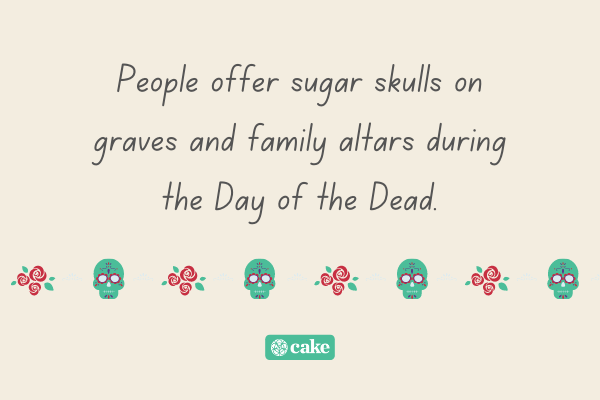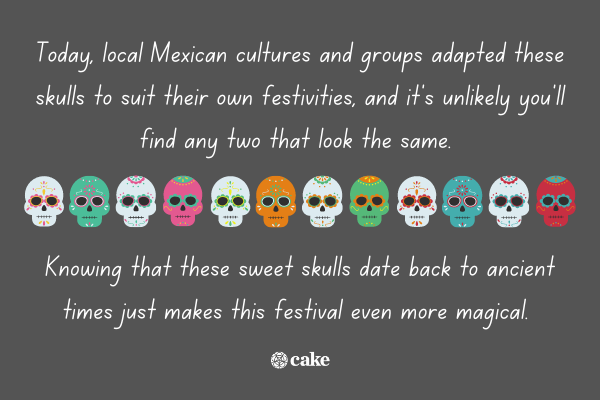The Skull and Skeleton in Art V Folk Art to Pop Culture
You've likely spotted sugar skulls in pop media, design, and fashion. These colorful skulls are symbols of the Day of the Dead or Dia de Los Muertos in United mexican states, and they've spread across the globe. On Day of the Dead each year, people place sugar skulls on graves and altars in accolade of their deceased loved ones.
This is a festival that's all about jubilant death and remembering 1'south family members.
Leap ahead to these sections:
- What is a Sugar Skull (Calavera)?
- What Do Sugar Skulls Represent?
- What's the Origin of Sugar Skulls?
- Where Do You Find Carbohydrate Skulls in Mexico and in Pop Culture?
How can a sugar skull be used to remember a family fellow member and laurels the dead? These skulls accept come a long way since their first use, and now they're symbols for a multifariousness of different things. Believe information technology or not, in some cultures, these sugar skulls have a language of their own, each one meaning something dissimilar. In this guide, we'll take a closer await at sugar skulls and what they represent.
What is a Saccharide Skull (Calavera)?

A sugar skull is a type of Calavera or representation of a homo skull. These are called sugar skulls since they're traditionally made of sugar. Today sugar skulls are often made of a diversity of things like chocolate, basics, and other treats.
These skulls play a big office in the Day of the Expressionless . This holiday follows All Saints' Day , and it's a fashion for people to honour their expressionless. Families flock to gravesites, offer gifts and food for their ancestors. People join together to eat, drink, tell stories, and celebrate the circle of life.
This is a time of year when the lines between the land of the living and the land of the dead blur. According to superstition, souls of deceased loved ones roam the earth, and these skulls are a reminder of that.
People offer sugar skulls on graves and family altars during the 24-hour interval of the Dead. They recognize the person who has passed, and the individual's name is written on the forehead of the skull. While it's a clear symbol of expiry, it'south also a symbol of life.
Skull Imagery in the Day of the Dead
If you lot've ever been to a Mexican funeral , you lot know they're lively affairs. The same is true during the Day of the Dead celebration in United mexican states, and you'll spot skull imagery around every corner. It's mutual for people to pigment their faces to look like colorful skulls, and information technology's also a common symbol for the country of Mexico during this time of year.
While information technology might seem morbid to an outsider, skulls are no stranger to Mexico. Since ancient times, Mexican people saw skulls as an important symbol of life. Only past accepting death and celebrating those who have passed can we become closer to life. In a civilization where the Land of the Expressionless isn't seen as and so far abroad, this type of skull imagery is but natural.
What Do Sugar Skulls Represent?
The symbolism of sugar skulls is in the proper noun itself. While skulls might conjure an prototype of the grotesque, as well as fear of death, the give-and-take sugar contradicts that. A "saccharide" skull implies that there's a certain sweetness in death.
Death doesn't have to be bitter and scary. It can also be sweet. But like the celebration of Dia de Los Muertos, sugar skulls are nearly celebration and not sorrow.
The sugar skulls are an offering to both the expressionless and the living. They're left on altars to ancestors as a reminder that someone is thinking of them. They're a form of appreciation. These skulls are besides given to the living as a sign of thoughtfulness. Friends and family unit gift sugar skulls to their loved ones during the Solar day of the Dead as a mode to show they care.
Naming the skulls
Today, these sugar skulls have come to take on a lot of unlike meanings. As said earlier, people often write the names of dead loved ones on the forehead of the skull when they make their offering.
This is a way of dedicating them to their loved ones and creating a special tribute. The name adds to the ofrenda (or offer) to deceased loved ones. Who doesn't want their memory to stay live?
Skull shapes and colors
Similarly, different skulls tell their own story based on shape. A small skull could be a sign that the skull is in award of an infant who passed. Larger skulls symbolize adults or elders. This is an important part of understanding the story backside the skull.
Family might also decorate the skull in a manner to resemble a family member, whether they draw a huge smile or crazy hair. All of these things are a way to represent the joy of life and death.
The color also has a significance of its own, and the pregnant might surprise y'all. The different colors take on their own significant , so hither's a unproblematic guide:
- Cherry: Claret
- Orange: Sunshine
- Yellow: Mexican marigold (a symbol of death)
- Purple: Pain
- Pinkish: Hope
- White: Purity
- Black: Land of the Dead
What's the Origin of Sugar Skulls?

The origin of sugar skulls dates back to the early days of the Aztec empire. While it's interesting to written report death in different cultures , it'due south also important to await dorsum in time at how people who came before united states of america also handled the passing of their loved ones. In Aztec culture , people would make altars for their dead similar to how they practise at present during the Mean solar day of the Dead. However, they would put real skeletons on them.
Once the Spanish explorers invaded the Aztec empire, they changed this tradition. Instead, they began making skulls with a saccharide paste. This is a technique that's actually from the Heart East. It's known as alfeñique , and it's traveled through Espana before arriving in the New World.
The technique involves mixing sugar, hot water, and lemon to create a moldable material that's similar to caramel. In addition to edible ingredients, clay was also used. Before long, this festival merged with similar Catholic holidays.
Today, thousands of years of culture and tradition become into these saccharide skull creations. Today, local Mexican cultures and groups adapted these skulls to adapt their ain festivities, and information technology's unlikely yous'll discover any ii that wait the aforementioned. Knowing that these sweet skulls date back to ancient times just makes this festival even more than magical.
Where Do You lot Observe Sugar Skulls in United mexican states and in Popular Culture?
Leading upward to and during the Day of the Dead celebration in Mexico, you'll come across sugar skulls just nigh everywhere. You'll find classic sugar skulls, too as other edible ones made with all kinds of delicious sweets. Vendors, markets, artisans, and more all have their own spin on these creations.
You'll also discover carbohydrate skulls in pop culture across the globe. They're popular in fashion, art, and films across the globe. The near famous representation recently was Pixar Animation's film Coco which took identify during the Solar day of the Dead commemoration. Saccharide Skulls are like shooting fish in a barrel to spot throughout the unabridged moving-picture show, so this is a swell way to see this symbol in activity.
Sugar skulls are now a pop home decor item nowadays. Unfortunately, since they've become so in-demand, they're likewise heavily commercialized. Non all of the symbols and colors used on sugar skulls manufactured in places like the United States are representative of the Day of the Dead.
Information technology's best to turn to traditional Mexican artists and creators to find an accurate, authentic skull. Luckily, as the sugar skull spreads, more than and more people are taking a closer look at its unique heritage and history.
Carbohydrate Skulls: The Smiling Face of Death
If there'due south one affair that's clear about sugar skulls, it's that they're non depressing or sad. In fact, the reverse is true. These colorful (and sometimes flavorful) skulls are a smiling symbol of death itself. They only go to bear witness that the things we fear oft aren't as scary as we recall.
Whether you're participating in a Dia de Los Muertos festival near you or y'all're interested in Mexican civilisation, sugar skulls are an open door to decease positivity. In United mexican states, people know expiry is unavoidable, and they use this cognition to celebrate life. Do the same for yourself by starting your stop-of-life planning . From in that location, the world is yours to explore.
Sources
- Valentina, Maura. "Alfeñique: Saccharide Fine art Jubilant the Day of the Dead." Study. Study.com .
- Wade, Lizzie. "Feeding the gods: Hundreds of skulls reveal massive scale of human being cede in Aztec capital." Science Mag. 21 June 2018. ScienceMag.org .
Source: https://www.joincake.com/blog/sugar-skull/
0 Response to "The Skull and Skeleton in Art V Folk Art to Pop Culture"
Post a Comment